Physical Address
304 North Cardinal St.
Dorchester Center, MA 02124
The concept of hip impingement was first described in the medical literature in the 19th century, and the idea that variations in hip morphology can contribute to secondary hip arthritis has been known for more than 100 years. The first surgical description of treating femoral head and neck deformities appeared in 1913, with good results following resection. The modern concept of femoroacetabular impingement (FAI) was formulated by Ganz et al. in 1999, and the understanding that FAI can eventually lead to osteoarthritis of the hip was described by Ganz and colleagues in 2003. This type of hip osteoarthritis was first described in adults in the 40- to 50-year age group. However, it is now recognized that FAI can cause serious joint damage among young athletes, even in their second and third decades.
FAI has been classically defined as an abutment between the proximal femur and the acetabular rim arising from morphologic abnormalities affecting the acetabulum, the proximal femur, or both. This repetitive mechanical conflict occurs mainly during activities involving extreme flexion and internal rotation of the hip, which can lead to lesions of the acetabular labrum and the adjacent acetabular cartilage. Two types of FAI have been classically described: a cam type ( Fig. 80.1 ) and a pincer type ( Fig. 80.2 ). Most cases of FAI are now recognized and classified as mixed cam-pincer impingement, as they usually involve both these mechanisms.
Cam impingement is caused by an aspherical femoral head moving inside the acetabulum. This may be seen as an osseous bump at the femoral head-neck junction or as a reduced or absent offset between the femoral head and neck. The osseous prominence on the femoral neck is similar to a cam, which is an eccentric part added to a rotating device, hence the name. This type of altered proximal femoral morphology has been classically described as the “pistol grip” deformity, best seen on anteroposterior (AP) pelvic radiographs; it may be due to a developmental disorder of the femoral head-neck junction (premature eccentric closure of the capital femoral physis), resulting in the nonspherical shape of the femoral head. Carsen et al., in a cohort study of pediatric patients, followed pre- and postphyseal closure using magnetic resonance imaging (MRI); they showed that the cam morphology was present exclusively in the closed physeal group. This finding suggested that the deformity likely developed during the period of physeal closure. It was also postulated that increased physical activity during this period was associated with the development of the cam morphology.
The cam deformity has also long been recognized as a sequela of a slipped capital femoral epiphysis, in which the posterior and inferior displacement of the capital epiphysis produces a prominence of the anterior and superior neck. It can also be associated with conditions like Legg-Calvé-Perthes disease and epiphyseal dysplasias and can be secondary to femoral neck fractures malunited in retroversion. During flexion, the nonspherical, eccentric portion of the head slides into the anterosuperior acetabulum, creating compression and shear stresses at the transition zone between the fibrous acetabular labrum and the hyaline articular cartilage and at the tidemark region of the articular cartilage. The labrum is pushed away from the joint and the articular cartilage is compressed and pushed centrally. With repetitive motion, this eventually results in separation of the cartilage from the labrum and from the subchondral bone of the acetabulum, creating the “carpet lesions” or chondral flap tears. Early in the disease process, persons with cam morphology develop more chondral pathology, with relative labral preservation. However, over time, the labrum also starts to fail, but only after the process is advanced on the articular surface. Cam impingement is typically seen in athletic men and often presents with problems in young adulthood. Some studies have reported a near 3 : 1 male predominance.
Pincer impingement is due to acetabular overcoverage and is caused by an overhanging anterolateral rim of the acetabulum, abutting on the femoral head-neck junction during hip flexion. This can occur due to overgrowth of the anterior edge of the acetabulum or the presence of a separate bony fragment at the anterior acetabular rim, referred to as an os acetabulum. The bony fragment may be a nonfused ossification center or a stress fracture of the acetabular rim, or it can be secondary to labral ossification. This type of impingement can also be caused by acetabular retroversion, which has been described as posterior orientation of the acetabular opening. Coxa profunda, or a deep acetabular socket, and protrusio acetabuli can also predispose to pincer impingement due to global overcoverage. The prominent anterior acetabular rim crushes the anterior labrum against the femoral head-neck junction during hip flexion and eventually leads to degeneration and failure of the acetabular labrum as a result of this repetitive microtrauma. A variable amount of damage to the articular cartilage of the acetabulum follows secondarily over time. This type of impingement is less commonly associated with severe anterior acetabular chondral damage as compared with the cam type, although “contrecoup” degeneration can occur on the posterior and inferior aspect of the acetabulum owing to leverage of the femoral head and subsequent overloading of the posterior aspect of the joint. The pincer type of FAI occurs more commonly in women, with the onset of symptoms frequently in middle age. Dynamic pincer impingement can also occur in normal hips, as seen in gymnasts and dancers, who have greater range of motion (ROM) in the hip.
Most cases of FAI have a combination of both these mechanisms, and the demographics are intermediate between the pincer and cam forms. Patients typically present with features of both labral and chondral damage caused by the pincer and cam deformities, respectively. The pattern of damage to the articular cartilage is a combination of the two patterns of damage, with the eventual outcome being influenced by the predominant type.
FAI has gained considerable attention in the last decade, ever since Ganz reported the vessel-sparing surgical dislocation (SD) of the hip joint and later, in 2004, used it for the treatment of FAI. In the past, these subtle deformities of the proximal femur and acetabulum were probably missed, and it is now believed by some surgeons that the majority of the cases of “primary” osteoarthritis are in fact, due to FAI morphology. With the increasing recognition that cam and pincer deformities predispose the hip joint to chondral and labral damage and eventual joint destruction, particularly in young athletes and individuals with greater ROM of the hips, the number of patients being diagnosed and treated for FAI has increased. However, it should be emphasized that these deformities are also commonly encountered in the pelvic radiographs of asymptomatic individuals in the general population. Hence FAI is not a radiologic diagnosis alone but a condition associated with groin or hip pain (symptoms) and limited range of hip motion with positive impingement signs (clinical signs) along with abnormal imaging findings.
The clinical presentation of patients with FAI can be variable, but most present with deep-seated intermittent hip or groin pain with hip rotation or during or after activity. The onset of the pain is usually insidious, but some athletes may report a specific injury or an acute precipitating event prior to the onset of symptoms. Patients may have pain or associated discomfort in the lateral hip, buttock, thigh, or low back regions. Groin pain may be referred to the anterior or medial thigh or to the symphysis pubis region in patients with anterior impingement. Byrd reported that athletes often demonstrate the “C-sign” in describing deep interior hip pain by cupping the hand above the greater trochanter with the fingers gripping into the anterior groin ( Fig. 80.3 ). Patients with posterior impingement may present with buttock pain or pain in the sacroiliac region. With chronic degeneration, the symptoms may become more constant with activity and less intermittent.
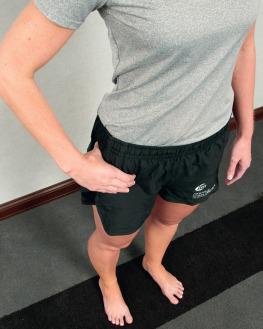
Athletes are usually aware of their limited hip mobility long before symptoms begin. However, they do not have major functional limitations, as the decreased ROM in the hip is compensated by increased pelvic and lumbosacral motion. These compensatory effects on the bony and soft tissue structures within the hip joint, hemipelvis, and the lumbosacral spine can lead to other conditions like athletic pubalgia, trochanteric or iliopsoas bursitis, sacroiliac joint dysfunction, and lower back problems, which usually coexist in patients with FAI. On examination, these secondary findings may be more evident and obscure the underlying element of primary hip dysfunction; therefore hip disorders can go undetected for a protracted period. In one study, Clohisy reported that patients presented with ongoing pain that had lasted for 12 to 16 months.
Mechanical symptoms like popping, locking, catching, snapping, and giving way have also been reported in patients with FAI. Patients with severe impingement may have difficulties with activities like prolonged sitting, squatting, or climbing up stairs. Patients with posterior impingement may have pain with activities like walking downhill or fast walking, where the hip is repeatedly hyperextended.
A thorough physical examination is important to clarify the source of the patient's pain and potential associated conditions ( Table 80.1 ). Physical examination may elicit tenderness in the groin or trochanteric region. On examination, almost all patients have diminished hip ROM, particularly flexion and internal rotation, caused by the altered bony architecture of the joint. However, patients may demonstrate reduced internal rotation without pathologic impingement due to other causes, such as decreased femoral anteversion, and some athletes with pathologic impingement may have normal or even increased internal rotation. Also, although only one hip may be symptomatic, the altered morphology is often present in both hips; thus the ROM must be examined in the other hip as well.
| Physical Exam Test | How to Perform | Definition of a Positive Test |
|---|---|---|
| FADIR test | Hip flexed to 90 degrees and the femur rotated from external to internal rotation while adducting the thigh. | Maneuver reproduces patient's typical pain from impingement of femoral head on acetabular rim/labrum. |
| Internal foot progression angle | Observe foot position during gait. | Greater than 15 degrees of internal rotation relative to the contralateral side indicates dynamic limitation in ROM. |
| Log-roll test | With patient in supine position, the affected leg is rolled internally and externally. | Pain present in the hip region suggesting intra-articular hip pathology. |
| Drehmann sign | Observe rotational profile when passively flexing the hip. | Presence of obligate external rotation, indicating limitations in ROM. |
| Posterior impingement test | Hip placed in extension and external rotation. | Reproduces patient's typical pain from posterior-based FAI. |
| FABER test | Hip flexed to 90 degrees, abducted, and externally rotated. | Reproduces patient's typical pain; may indicate posterior impingement. |
| Trendelenburg sign | Patient stands on one leg. | Pelvis drops on contralateral side, indicating abductor weakness. |
The FADIR (flexion, adduction, internal rotation) impingement test is a very sensitive test for FAI but not necessarily specific, as it can be positive in any irritable hip condition ( Fig. 80.4 ). With the hip in 90 degrees of flexion, the joint is progressively rotated from external to internal rotation while moving from abduction to adduction. To be considered positive, this maneuver should reproduce the patient's typical pain experienced with activities. Using this maneuver, it is possible to identify the most likely position of impingement and the most likely area of the acetabular rim injury. This exam test may be somewhat uncomfortable, so it is better to perform it on the asymptomatic side first and then compare with the symptomatic hip. The internal foot progression angle walking (FPAW) test is more specific though less sensitive than FADIR testing for the diagnosis of FAI. A positive internal FPAW test is the presence of hip pain on walking with the ipsilateral foot 15 degrees internally rotated from the baseline gait pattern. The log-roll test, although not sensitive, is the most specific test for hip joint pathology independent of its etiology. Rolling the leg back and forth rotates only the femoral head in relation to the acetabulum without stressing any of the surrounding structures. The Drehmann sign may be seen in patients with FAI and is considered positive if there is an unavoidable passive external rotation of the hip when a hip flexion is being performed. However, it can also be positive in slipped capital femoral epiphysis, Legg-Calvé-Perthes disease, and avascular necrosis of the femoral head.
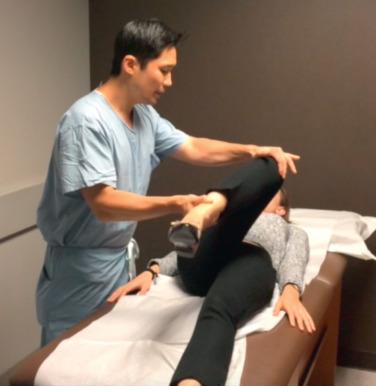
Posterior impingement may occasionally be encountered and is assessed by the “posterior impingement test,” placing the hip in extension and external rotation ( Fig. 80.5 ). The test is considered positive if it reproduces the patients’ typical pain or if there is decreased ROM. The FABER test places the hip in flexion-abduction-external rotation. Lateral-sided hip pain and increased distance between the lateral knee joint line and the examination table have been reported during the FABER test in patients with posterior impingement.
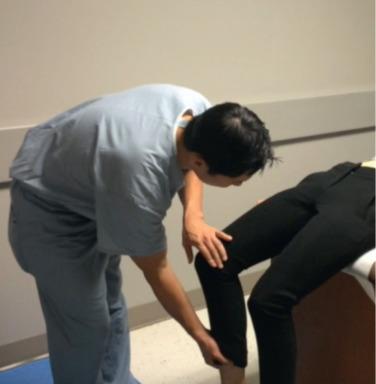
Additional tests that should be part of a thorough hip examination include assessing the gait, straight-leg raise, single-leg control, and investigation of any secondary findings in the symphysis pubis, sacroiliac joints, lumbar spine, and the trochanteric region due to conditions commonly encountered in FAI as a result of the compensatory pathomechanics.
A mild to moderate limp is common, occurring in up to 71% of patients. Abductor weakness is often seen on the affected side, with a positive Trendelenburg sign. The pelvis should be examined for any anterior tilt, which may be the cause of focal anterior overcoverage and pincer impingement. Patients may have exaggerated lumbar lordosis associated with the anterior tilt of the pelvis and also exaggerated lumbar spine mobility as a compensation for the reduced hip motion. They may also have limb-length discrepancy secondary to coxa vara, which has been associated with cam impingement or anterior tilt of the hemipelvis.
Lateral pain may be present from trochanteric bursitis, and posterior pain and tenderness may be present at the ischial tuberosity from chronic hamstring tendinopathy due to the adaptive posterior tilt of the pelvis seen in patients with FAI who are attempting to reduce anterior impingement. Posterior tenderness may be present within the gluteal muscles from overfiring in an attempt to splint the joint. Posterior sacroiliac joint tenderness may be present from sacroiliac joint dysfunction, which is more common in patients with acquired FAI due to labral ossification. The lower abdominal and adductor area must be carefully palpated to localize tenderness suggestive of athletic pubalgia. This tenderness can mimic or coexist with FAI. Pain with resisted hip adduction or situps should raise a suspicion for athletic pubalgia.
The radiologic assessment of any patient with hip pain and suspected FAI should begin with conventional radiography. Our preference for the initial radiographic evaluation of a patient with suspected FAI includes a well-centered AP pelvis view, a Dunn lateral view, and false-profile view of the affected hip ( Fig. 80.6 ). These views allow for an initial assessment of the cam and pincer lesions associated with impingement while also evaluating other acute or chronic changes including secondary joint destruction.
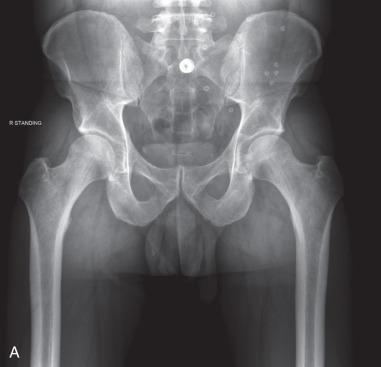
It is important to maintain neutral pelvic tilt and rotation in AP radiographs, with the tip of the coccyx centered in the midline and the distance between the midportion of the sacrococcygeal joint and the upper border of the symphysis pubis between 32 and 47 m, to correctly identify pincer impingement. Overcoverage of the anterior acetabulum, characteristic of pincer impingement, is evaluated by the presence of the crossover sign, posterior wall sign, and the prominent ischial spine sign. The crossover sign is positive when the cranial part of the anterior acetabular wall is more lateral than the posterior wall, creating a figure-of-8 configuration indicative of focal acetabular retroversion ( Fig. 80.7 ). The posterior wall sign is positive when the posterior acetabular wall lies medial to the center of the femoral head ( Fig. 80.8 ). This indicates that the posterior wall is deficient and is usually associated with acetabular retroversion. It is important to recognize this, as it puts the patient at risk for iatrogenic posterior instability with isolated anterior wall decompression. A prominent ischial spine sign can be seen on an AP radiograph and is also indicative of acetabular retroversion ( Fig. 80.9 ).
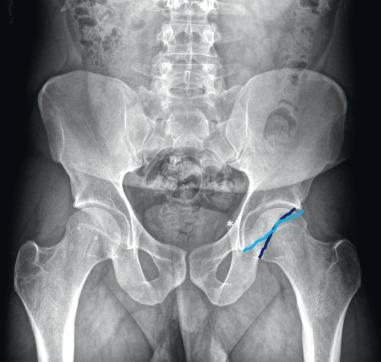
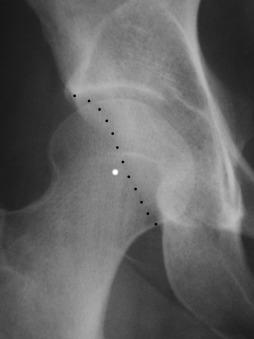
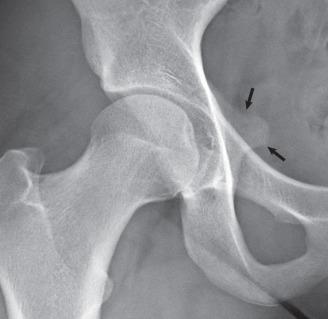
Global overcoverage may be associated with coxa profunda or protrusio acetabuli, both of which are accompanied by an excessive center-edge angle. Coxa profunda is present when the floor of the acetabular fossa is medial to the ilioischial line ( Fig. 80.10 ). Protrusio acetabuli is present when the femoral head overlaps the ilioischial line medially ( Fig. 80.11 ). The lateral center-edge angle (LCEA) can be used to assess lateral overcoverage, with values greater than 40 degrees indicative of pincer morphology ( Fig. 80.12 ). Other findings of rim impingement include rim fractures, a downsloping sourcil, Tönnis angle below 0 degrees, presence of labral ossification causing the appositional bone sign, os acetabuli and saddle-like callus formation at the impact area of the femoral neck. A synovial herniation pit may be present in the region of the anterolateral femoral head-neck junction in patients with FAI, seen on conventional radiographs as a region of decreased bone density with well-defined borders. The 45-degree Dunn view, frog-leg lateral view, and the profile view in impingement position (PIP) have also been used for assessment of the femoral cam morphology and quantification of the asphericity of the femoral head with the alpha angle ( Fig. 80.13 ). Values greater than 50 degrees are indicative of cam deformity.
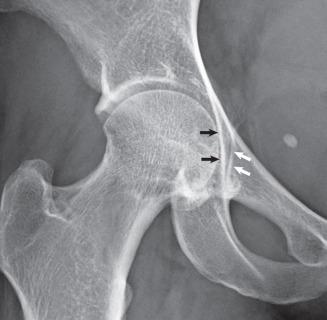
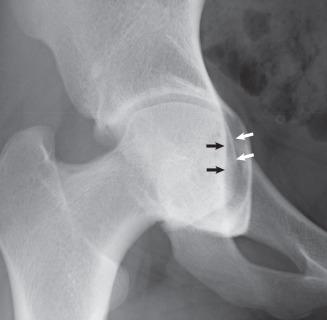
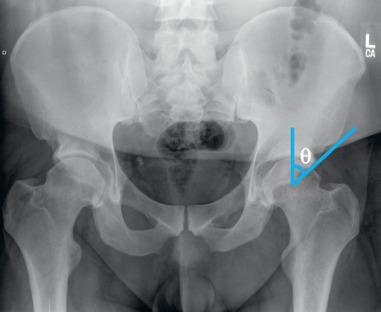
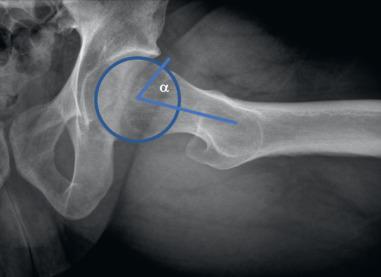
Lequesne's false-profile view, obtained with the patient in a standing position with the affected hip against the cassette and the pelvis rotated 65 degrees in relation to the wall stand, is used to quantify anterior overcoverage. An anterior center-edge angle (ACEA) greater than 40 degrees indicates excessive anterior overcoverage. This view is also used to assess the morphology of the anteroinferior iliac spine and contrecoup lesions seen in the posteroinferior part of the hip joint.
Nepple et al. utilized a clock-face technique (the superior femoral neck is 12 o'clock and the anterior neck is 3 o'clock) to correlate the position of the head-neck junction profiled on plain radiographs with radial oblique computed tomography (CT) reformats. The 12 o'clock position is seen with the AP pelvis radiograph, 1 o'clock with the 45-degree Dunn view, 2 o'clock with the frog-leg lateral view, and 3 o'clock with the cross-table lateral view. Given the typical location of cam deformities at the anterolateral femoral head-neck junction (1 o'clock), the deformity is most readily identified on the 45-degree Dunn view, where the hip is abducted 20 degrees and flexed to 45 degrees. Compared with the Dunn view, the frog-leg lateral view has greater specificity for detecting cam morphology.
It is crucial that all radiographs be scrutinized for evidence of acetabular dysplasia, as acetabular dysplasia may coexist with FAI or be the primary pathology in a patient presenting with hip pain. Radiographic findings concerning for acetabular dysplasia include an LCEA below 25 degrees and a Tönnis angle greater than 10 degrees on the AP pelvic radiograph (see Fig. 80.5 ) and an ACEA below 20 degrees on the false profile view.
MRI is useful in the assessment of osseous morphological abnormalities, labral lesions, cartilage status, and associated soft tissue injuries seen in patients with FAI as a result of compensatory mechanisms. MRI is also useful in alpha-angle measurement and quantification of the cam deformity. If possible, all imaging should be performed using a high-resolution 1.5-Tesla or greater MRI scanner to allow for improved resolution in evaluating the articular cartilage, labrum, and surrounding soft tissues. Saied et al. showed that conventional MRI (cMRI) has better sensitivity for the detection of labral lesions (86%), than for chondral lesions (76%).
Labral degeneration of pincer impingement manifests as increased signal within the labrum on fluid-sensitive MRI sequences, such as T2-weighted and short TI inversion recovery (STIR) sequences. Labral tears are manifest as linear fluid signal intensity extending from the labral surface into the substance of the labrum ( Fig. 80.14 ). True labral tears are commonly seen in the anterosuperior labrum in patients with FAI and must be differentiated from naturally occurring clefts or sublabral recesses, which are usually seen in the inferior labrum and typically do not extend the full thickness of the labrum. Labral hypertrophy can be indicative of underlying acetabular dysplasia.
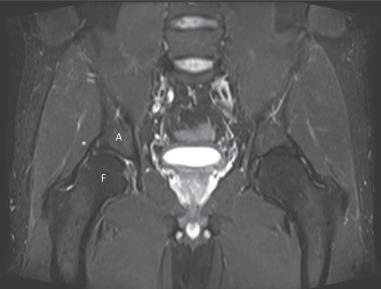
Increased signal intensity in the anterior acetabulum on T2-weighted images is indicative of subchondral edema and suggests failure of the overlying articular surface ( Fig. 80.15 ). Paralabral cysts and subchondral cysts ( Fig. 80.16 ) are also indirect signs of labral and chondral injury, respectively. Beaulé et al showed that radial images are more sensitive to the presence and size of the cam deformity than conventional oblique axial images and recommended that radial imaging be considered in patients with FAI.
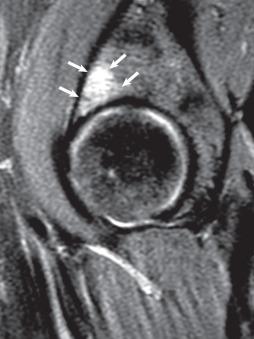
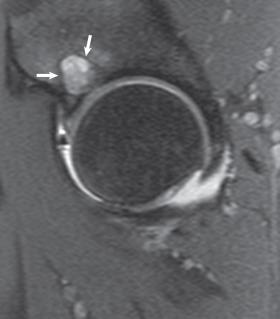
Magnetic resonance arthrography (MRA) is MRI enhanced with intra-articular gadolinium contrast; it allows for the evaluation of intra-articular hip pathology. MRA provides better visualization of the joint anatomy owing to easy differentiation of the joint surface and a higher soft tissue contrast obtained by intra-articular gadolinium dilution. Contrast material may be introduced directly by intra-articular injection into the joint, as in direct magnetic resonance arthrography (dMRA), or indirectly by intravenous injection, as in indirect magnetic resonance arthrography (iMRA). The advantages of iMRA over dMRA are that it is simple, less time-consuming, and less invasive; hence it may be more accepted by patients.
The addition of a long-acting anesthetic to the intra-articular gadolinium in dMRA can provide additional diagnostic value. The athlete is asked to perform pain-provoking activities, to generate pain prior to the intra-articular injection of diluted contrast material and local anesthetic agent, and postcontrast images are obtained after the injection. Temporary symptom relief after injection verifies an intra-articular source of pain. The drawback of dMRA as compared with cMRI is that it is invasive, with some patients experiencing postprocedural pain.
Delayed gadolinium-enhanced magnetic resonance imaging of cartilage (dGEMRIC) is a newer imaging technique that involves intravenous gadolinium administration followed by a short period of exercise and subsequent imaging after 60 minutes. The distribution of gadolinium in the cartilage is inversely proportional to its glycosaminoglycan content. Areas of chondral degeneration with decreased glycosaminoglycan will therefore have increased gadolinium concentration. This protocol can be a useful adjunct when there is a concern for articular cartilage degeneration, as preexisting chondral damage is a known risk factor for poor outcome following hip preservation surgery. Hesper et al. recently reported that, with increasing concerns about the use of contrast agents, 3-Tesla MRI with noncontrast T2 mapping may be a useful alternative to dGEMRIC to assess cartilage damage at the chondrolabral junction.
CT provides better information regarding the bony architecture than MRI, therefore it can be a useful adjunct in planning bone resection during arthroscopic hip preservation surgery. CT scans can be especially helpful in identifying focal rim lesions such as cephalad retroversion and differentiating these from true acetabular retroversion. They also permit direct quantification of acetabular version and depth. Werner et al. reported that the equatorial-edge angle (EE angle) can be used to measure acetabular retroversion on CT scans and that this was the angle of the acetabular opening with the sagittal plane at the CT slice showing the maximum diameter of the femoral head. Three-dimensional (3D) reconstruction of CT images provides the best picture of the cam deformity ( Fig. 80.17 ). Software programs can be applied to 3D CT images to model areas of impingement and plan the level and amount of bone resection needed.
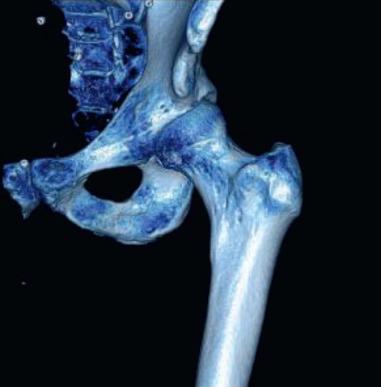
Lerch et al. reported that ultrasound is as reliable as plain radiographs in the diagnosis of cam-type FAI and found no significant difference between the alpha angles on MRI, frog-leg lateral-view radiographs and ultrasound in patients with FAI. However, musculoskeletal ultrasonography is considered to be operator-dependent, and hip ultrasound examination is not routinely included in the initial imaging of FAI.
Intra-articular injection of a local anesthetic agent is a useful adjunctive tool in the diagnosis of FAI. Corticosteroids can be added to the injection as a therapeutic measure. The injection can be performed under ultrasound or fluoroscopic guidance in the office setting or in combination with intra-articular gadolinium administration for MRA. Patients are instructed to perform pain-provoking activities after the injection. Significant or complete relief of pain with injection signifies an intra-articular source of pathology. Patients who have little or no pain relief after injection should be assessed for potential extra-articular sources of impingement, such as subspinal impingement or other pelvic or lumbar spinal pathology. Khan et al. reported that injections performed under ultrasound guidance were better tolerated than those performed under fluoroscopic guidance, although both methods allow for confirmed introduction of the injection into the hip joint.
The mainstay of conservative management of FAI is the early recognition of the condition, identifying athletic activities that provoke pain/symptoms and modifying the activities, as would be appropriate for the patient's level of athletic participation. It includes symptomatic management with anti-inflammatory medications and also physical therapy.
Since FAI and associated reduced hip ROM can result in compensatory mechanisms, with resultant injury to the surrounding musculature and bony structures, physical therapy directed toward improving mobility may provide symptomatic relief. Therapy should also be directed toward improving muscular strength around the hip joint and core muscle strength and, more importantly, should be customized to address the individual needs of patients and their athletic demands. Although a trial of physical therapy may be appropriate in the initial symptomatic management of FAI, there is no evidence to suggest that it will alter the natural history of the condition and the progression of degenerative changes. Also, to date, there are no randomized clinical trials comparing conservative and surgical interventions for FAI.
The decision to proceed with operative treatment is based on a combination of patient history, physical examination, imaging studies, failure of conservative management, and temporary relief with diagnostic intra-articular injection. Successful treatment outcome requires a comprehensive approach, addressing both the primary deformity and the resultant intra-articular damage.
Surgical treatment of FAI was first described utilizing an open vessel-sparing SD with a trochanteric osteotomy. This method is still used in patients with severe deformities such as those secondary to Perthes disease and slipped capital femoral epiphysis, which are associated with relative femoral neck shortening. Distalization of the trochanteric osteotomy would lead to relative lengthening of the femoral neck in such cases. Also, an open procedure may be applicable when a periacetabular or proximal femoral osteotomy is needed, as in cases associated with acetabular dysplasia or femoral neck deformities. Combined hip arthroscopy and a limited open approach for the treatment of cam-type impingement has also been reported.
Arthroscopic surgery for the treatment of FAI was first reported by Philippon et al. in 2005 and is currently the technique preferred by most surgeons. Patients treated with hip arthroscopy show a trend toward faster recovery. However, incomplete decompression of the impinging lesion is common and is the leading cause of recurrent pain and revision surgery in patients undergoing hip arthroscopy.
Hip arthroscopy is typically performed on a traction table, preferably in the supine position ( Fig. 80.18 ), utilizing a minimum of two arthroscopic portals ( Fig. 80.19 and Table 80.2 ). Distraction of the hip joint by at least 10 mm and the use of multiple accessory portals are important in gaining access and improving visualization of the hip joint. The procedure begins with fluoroscopic localization of the anterolateral portal, located 1 cm anterior and 1 cm proximal to the anterolateral border of the greater trochanter. This portal should enter the hip capsule at 12 o'clock. Next, the anterior portal is established under direct visualization, located 1 cm lateral to a vertical line drawn from the anterosuperior iliac spine (ASIS) and 1 cm distal to a horizontal line from the anterolateral portal, entering the capsule at 2 o'clock. An interportal capsulotomy can be performed between these portals to allow for improved visualization and access with instruments. Most pathology in the central compartment can be addressed with these portals, as the typical injury pattern is primarily anterior, although a posterolateral portal can be established 1 cm proximal and 1 cm posterior to the posterolateral border of the greater trochanter if access to the posterior joint is needed. The procedure typically begins by addressing the pathology in the central compartment ( Fig. 80.20 ), including the pincer deformity as well as any chondrolabral injury. If a labral tear is identified, the acetabular rim is débrided with a motorized burr and suture anchors are placed to reattach the labrum. Once pathology in the central compartment has been fully addressed, traction is released. With a restored labrum, the suction seal can be visualized as the femoral head is reduced back into the acetabulum.
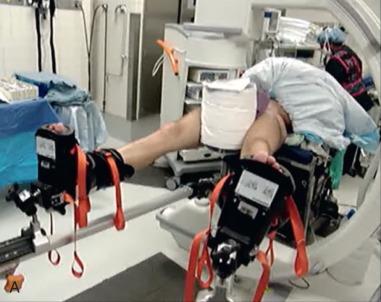
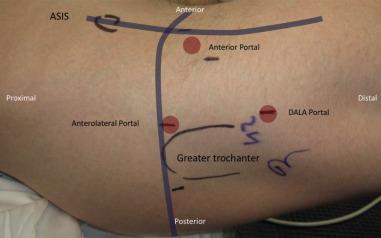
| Arthroscopic Portal | Location of Portal |
|---|---|
| Anterolateral portal | 1 cm proximal and 1 cm anterior to the anterolateral border of the greater trochanter |
| Anterior portal | 1 cm lateral to the longitudinal line from the ASIS and 1 cm distal to the horizontal line from the anterolateral portal |
| Distal anterolateral accessory portal | 4–6 cm distal to the anterolateral portal |
| Posterolateral portal | 1 cm proximal and 1 cm posterior to the posterolateral border of the greater trochanter |
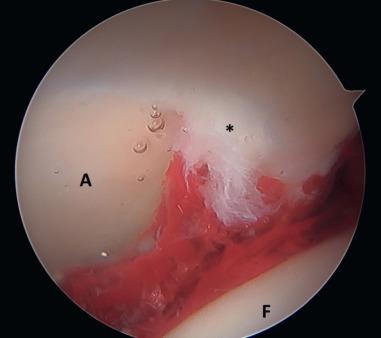
Then the arthroscope is advanced into the peripheral compartment for decompression of the cam deformity. A distal anterolateral accessory portal, established under direct visualization, may be made 4 to 6 cm distal to the anterolateral portal. The use of extensive capsulotomy (interportal, H -shaped, or T -shaped) has been described to improve access to pathology in both the central and peripheral compartments. The T-type capsulotomy with a short transverse interportal part and a vertical part along the femoral neck to the intertrochanteric line is preferred to avoid damage to the retinacular vessels. Capsular management continues to be an area of controversy in the management of FAI. Although some authors argue that anatomic closure is required to restore the stability of the hip, others do not. Nho and his colleagues reported improved sport-specific outcomes in patients with FAI who underwent complete closure of the T-capsulotomy as opposed to patients who had partial repair. However, Domb et al. found no significant difference in patient-reported outcome scores between patients with repaired and unrepaired capsulotomies after controlling for various confounding variables. Our preference is to perform a T-capsulotomy in most cases to allow for greater visualization and to routinely perform a capsular closure to limit the risk of postoperative iatrogenic instability.
Become a Clinical Tree membership for Full access and enjoy Unlimited articles
If you are a member. Log in here